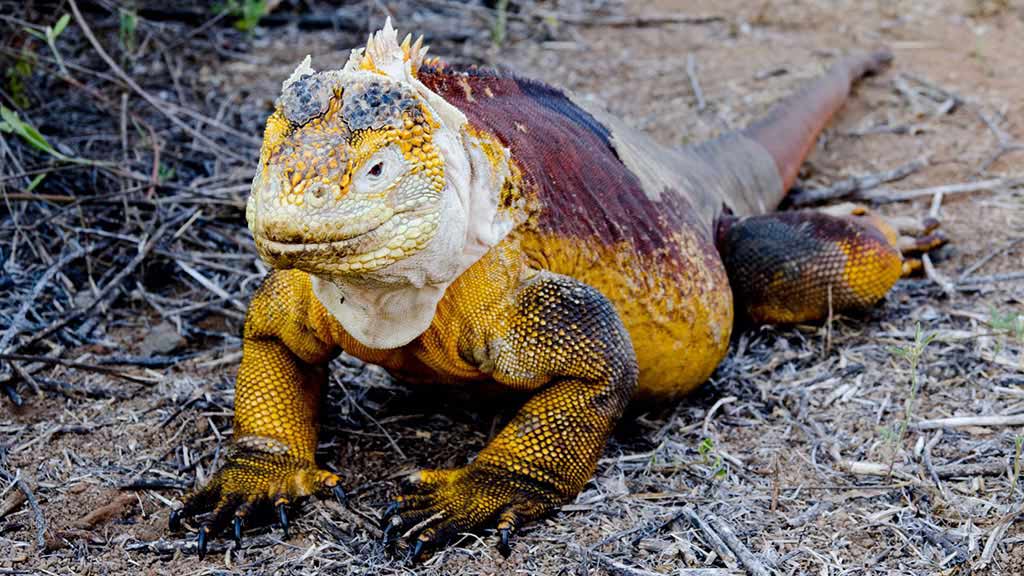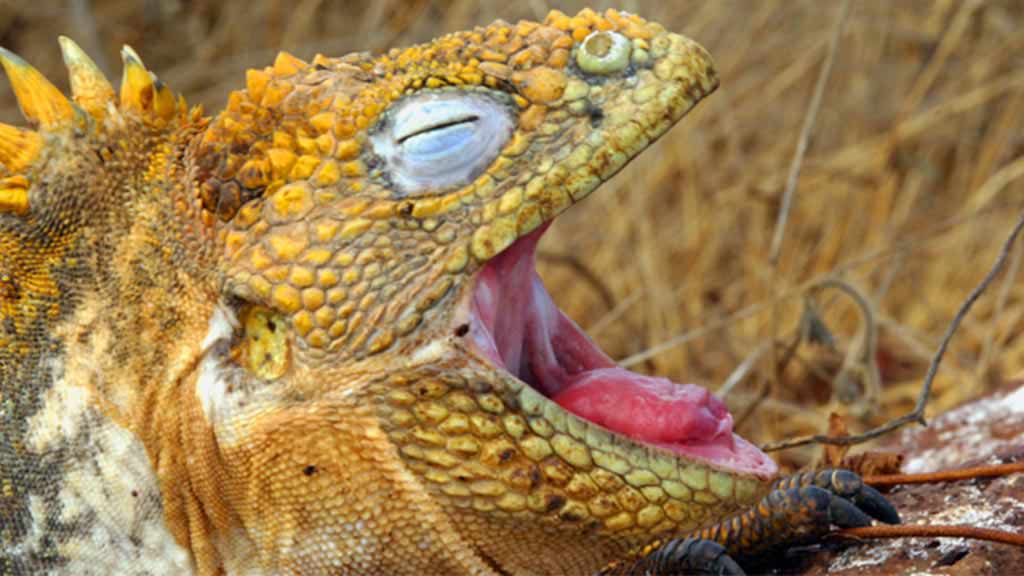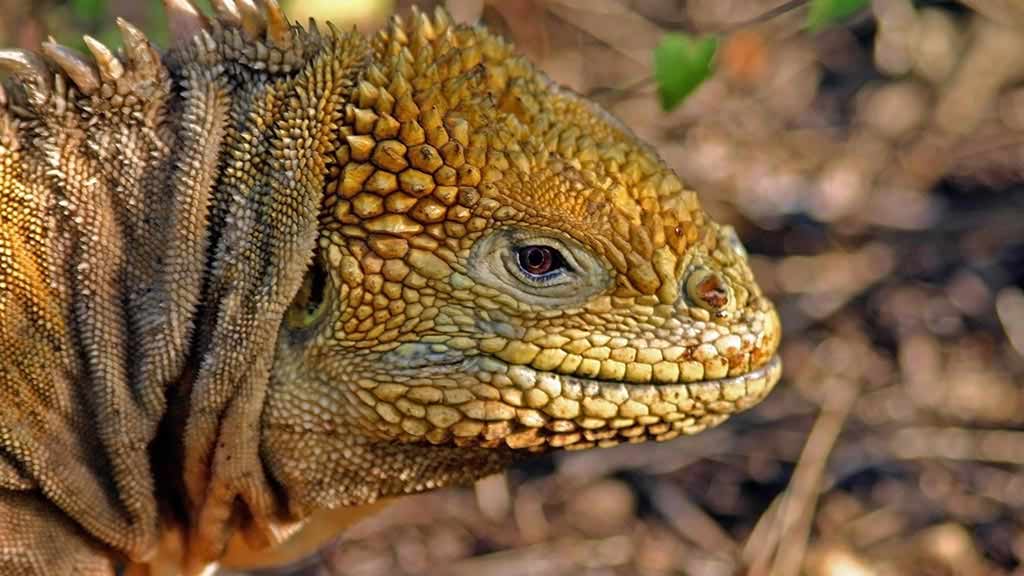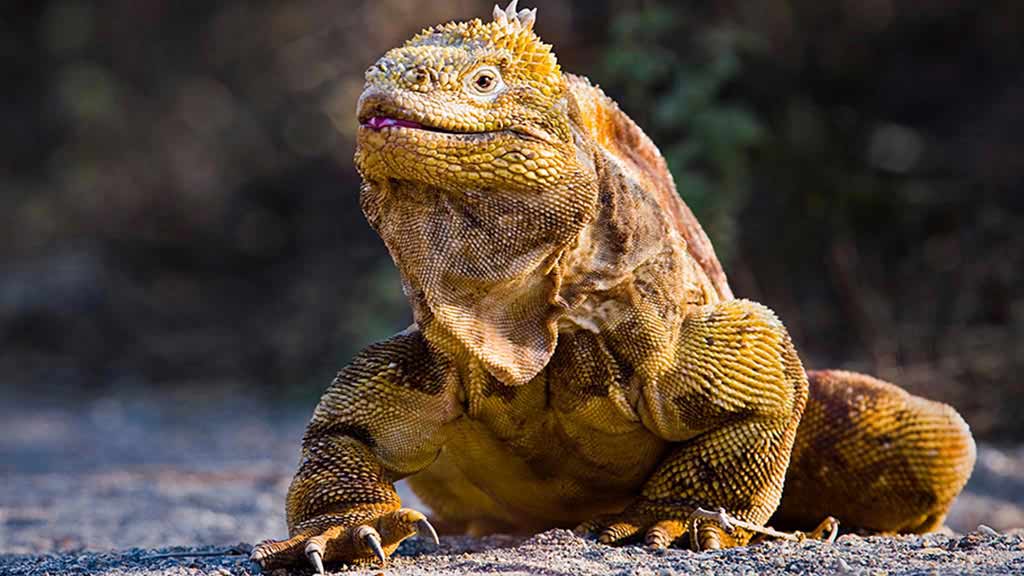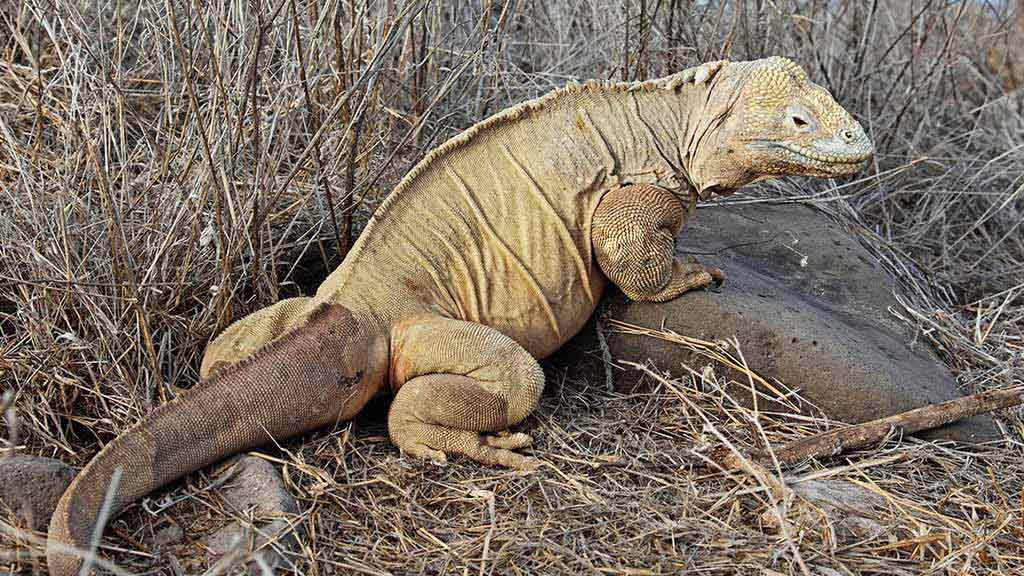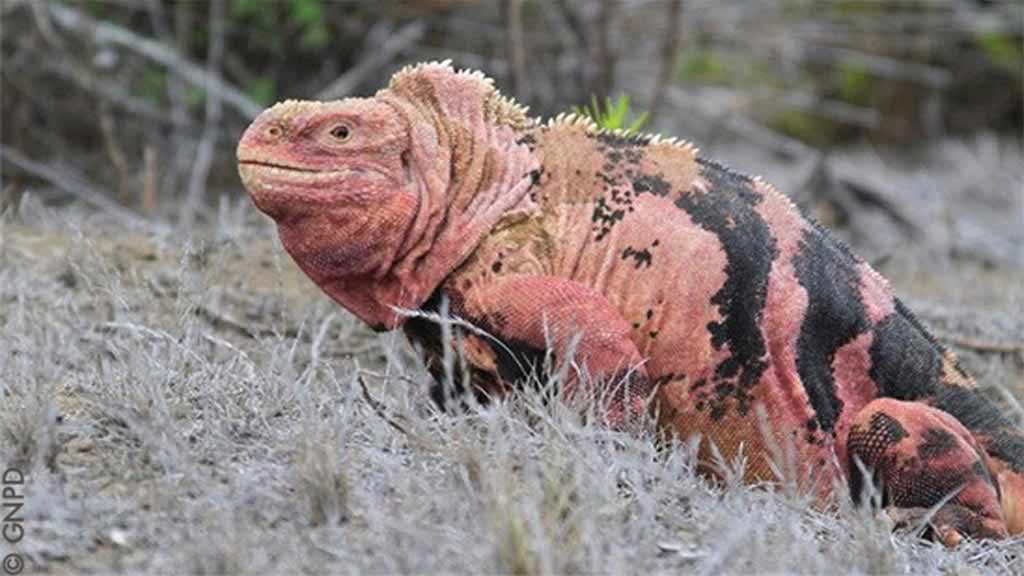Galapagos Land Iguana
The Galapagos Land Iguana is an iconic species not to be missed on the Galapagos Islands. Today we find three different Galapagos land iguana species in the archipelago, all of which are endemic. If you go to the right visitor sights then they are relatively easy for visitors to cross paths with. These little fellas have a kind of prehistoric-looking charm about them and are extremely photogenic. Under the early morning light, Galapagos Land Iguanas often glow a radiant color of gold. Incredibly there is even a Pink colored Galapagos Land Iguana species that was discovered only in 2009. There's also an interesting story to tell of land iguana evolution at the Galapagos.
Keep reading for everything you need to know about the Galapagos Land Iguana. Which different land iguana species exist in Galapagos? Where and how is best to see them? Why are Galapagos land iguanas endangered? Plus lots more interesting Galapagos Islands land iguana facts & information.
SECURE YOUR GALAPAGOS TRAVEL
Get a FREE personalised quote todayGalapagos Land Iguana Adaptations & Evolution
When visiting the Galapagos Islands back in 1835 Charles Darwin was certainly less than flattering in his description of the Galapagos land iguanas that he encountered. He went as far as to call them “ugly” and “stupid in appearance”, but we think he was being rather harsh.
Galapagos land iguanas vary in color from yellow to orange, and in good light can even appear to have a beautiful golden sparkle. Other distinguishing features include spines that run down their backs, a pink tongue, and an enigmatic Mona Lisa smile. T
The story of how land iguanas originally arrived in the Galapagos Islands is also fascinating. All Galapagos iguanas are believed to have descended from a common mainland ancestor. They likely crossed the ocean by floating on foliage and organic debris that washed into rivers and drifted on strong currents to the Galapagos archipelago. This single Iguana species then evolved uniquely on each different island, depending on differences in habitat and food sources found there. This explains the three different Galapagos land iguana species we find in Galapagos today. On some islands, there was even an unbelievably divergent adaptation into Marine Iguanas – the only Iguana species capable of swimming, which it does to feed on algae in the sea.
Galapagos Land Iguana Behavior
Galapagos land iguana Size
The Galapagos land iguana is a fairly large reptile, capable of reaching up to 5 feet in length over their 50-60 year lifespan. A large adult may weigh as much as 13kg (25 pounds).
Galapagos land iguana Habitat
Galapagos land Iguanas prefer dry and arid areas of the archipelago. In the mornings you’ll often see them sprawled out under the rising sun to warm up, while around midday they retire to the shade underneath cacti plants. At night land iguanas sleep in underground burrows to conserve body heat - you may spot these holes in the ground beside Galapagos visitor trails.
Galapagos land iguana Diet
What do Galapagos land iguanas eat? The diet consists mostly of Prickly pear (Opuntia) cactus fruits and pads. The cactus spines prevent them from climbing for fruit, so instead they wait patiently in the shade until the food drops naturally to them. They swallow cactus pads, spines, and all, and rely on this moisture to survive during long, dry periods. Galapagos Land iguanas are herbivores and will also eat other low-hanging vegetation if cactus fruits are not in season.
Why do land iguanas hang out with Darwins Finches?
There is another interesting Galapagos land iguana behavioral trait that visitors can observe - the fact that they are often seen hanging out alongside Darwin's Galapagos finches. This is in fact a fascinating symbiotic relationship. Land Iguanas are accustomed to raising themselves from the ground to allow finches to remove ticks and parasites from their bodies. This is a good deal for all involved - The finch gets a tasty meal, while the Iguana receives a free cleaning service.
How to See a Galapagos Land Iguana?
The good news is that it is quite easy for visitors to spot Galapagos land iguanas in the wild. The best islands to see them include North Seymour, Santa Fe, Espanola, and South Plaza. All of these islands can be visited as part of a Galapagos cruise itinerary or can be included in a Galapagos Land Tour. On these islands, it is common to come face to face with a Galapagos Land Iguana right along the trail.
Failing that it's also possible to see Galapagos Land Iguanas in captivity at the Charles Darwin Research Station in Puerto Ayora, Santa Cruz. These are in fact the last of the Santa Cruz Land Iguanas saved from extinction. Aggressive introduced species such as feral cats and dogs have destroyed land iguana habitats and also hunt baby iguanas and eggs. So the iguanas that you see here are protected to continue their important lineage.
The Galapagos land iguana can be spotted year-round. Land iguana nesting and breeding seasons vary between islands, beginning in January on Isabela & South Plaza, June on Fernandina, and September on Santa Cruz Island.
Contact us for a FREE GALAPAGOS TOUR QUOTE. We’ll be happy to help you organize your Galapagos vacation to see Land Iguanas and all of the other unique & wonderful wildlife here.
GET FREE ADVICE
From a Galapagos destination expert today3 Different Species of Galapagos Land Iguana
At the Galapagos Islands today we find three different species of Land Iguana: 1. Galapagos Land Iguana, 2, Santa Fe Iguana, and 3. Pink Land Iguana. All are unique, endemic species that can only be found here, and nowhere else on the planet.
On South Plaza island there is also the unusual curiosity of a hybrid iguana - the result of intergeneric breeding between a male marine iguana and a female land iguana. Read on to learn more about each Galapagos land iguana species.
1. Galapagos Land Iguana
ENDEMIC SPECIES
Conservation Status: Vulnerable
Scientific Name: Conolophus Subcristatus
Where to see the Galapagos land iguana? On Fernandina, Isabela, Santa Cruz, South Plaza, Baltra, Santiago and North Seymour islands.
When to See Them: The Galapagos land iguana is active all year round.
The Galapagos Land Iguana is the most common and widespread of the land iguana species at Galapagos. They can be found across seven different islands of the archipelago. In appearance the Galapagos land iguana has yellow skin covered in yellow and brown blotches, a short head and powerful legs with sharp claws for digging.
The Galapagos Land Iguana is listed as a vulnerable species on the IUCN Red List, and have seen declining population numbers over the last century. The biggest threat to the Galapagos land iguana is that of introduced animals such as goats, dogs, and cats. They are especially at risk during the first year of their lives after hatching, with many Galapagos predators looking for an easy meal. Until 2019 they were extinct on Santiago Island, but following a successful reintroduction project it is hoped that land iguanas will once again thrive there.
2. Santa Fe Land Iguana
ENDEMIC SPECIES
Conservation Status: Vulnerable
Scientific Name: Conolophus Pallidus
Where to see them: Santa Fe Island.
When to see them: All year round.
The Santa Fe Land Iguana, as their name suggests, can only be found on the island of Santa Fe off of the east coast of Santa Cruz. They are also sometimes referred to as the Barrington Land Iguana, after the original English name for Santa Fe island.
Compared to the common Galapagos land iguana, the Santa Fe land iguana is slightly larger, with paler yellow coloring, smaller dorsal spines, and a more tapered snout. Today, there are over 7,000 individuals living on this small island. They can often be spotted close to the trails, but visitors need a kean eye as their colors blend in perfectly with the arid habitat providing them with wonderful camouflage. Don't worry, your naturalist guide will be sure to point them out and tell you more about them.
Despite their healthy population numbers, the Santa Fe Land Iguana is considered vulnerable because they are found in just one single place on the planet. This leaves them at potential risk to one off extreme events such as fire or drought. Introduced feral goats used to roam free on Santa Fe island, destroying land Iguana eggs and habitat. Fortunately this threat was recognised and the goats were removed back in the 1970s. This gave the Santa Fe population a fresh foothold from which they have bounced back impressively.
3. Galapagos Pink Land Iguana
ENDEMIC SPECIES
Conservation Status: Critically Endangered
Scientific Name: Conolophus Marthae
Where to find them: Galapagos pink iguanas live in just one single place on the planet. Their home is on the slopes of Wolf Volcano on Isabela Island, a site which is unfortunately off-limits to tourist visitors. It is not possible to observe them in the wild at this time.
The Pink land iguana has survived at the Galapagos Islands for the past 5.7 million years, yet incredibly was only recently discovered and identified as a unique species in 2009. This is testament to the fact that the Galapagos islands still hold many secrets even in this modern age. The Pink Galapagos Land Iguana is easy to identify due to its salmon pink body colour caused by lack of skin pigment, and the black striped markings that cover their body.
Today there are as few as 200 surviving pink iguana individuals, all found within a very small habitat range on Wolf Volcano. Scientific studies are ongoing to understand more about this critically endangered reptile, and to protect them in their risky natural habitat on the slopes of an active volcano.
Why is the Galapagos Land Iguana endangered?
All three Galapagos land iguana species are vulnerable to predation. Baby Galapagos land iguana predators include Galapagos hawks, especially when under one year old. While feral cats are capable of hunting larger iguanas up to four years of age. Other invasive species like goats, pigs and dogs also eat iguana eggs or destroy nests and habitat.
An example of the impact of invasive species over time can be observed on Santiago island where the Galapagos land iguana became extinct, and has only recently been reintroduced.
Fortunately, today there are active conservation projects underway to protect Galapagos land iguanas. The Galapagos land iguana project supported by the Conservation Trust has gathered valuable data through tagging adult iguana on various different islands. This data was used to plan the successful reintroduction of land iguanas onto Santiago island in 2015, and also to monitor progress of the same population.
The #1 Trusted
Galapagos Travel Agency
If you enjoyed reading this article, then check out our other posts about Galapagos Birds and Animals.
In conclusion, the Galapagos land iguana has a long & important history at the islands. Today they are under threat, but visitors can also see postive conservation steps & reintroduction projects. The incredible pink land iguana is also a great example of species adaptation and the constant fight for suivival. So, if you visit the Galapagos Islands, do try to spot one of these interesting creatures, and ask your guide to tell you more about them. Land iguanas are one of the true galapagos icons, and hopefully with a little help they will still be here for future generations to enjoy too.




